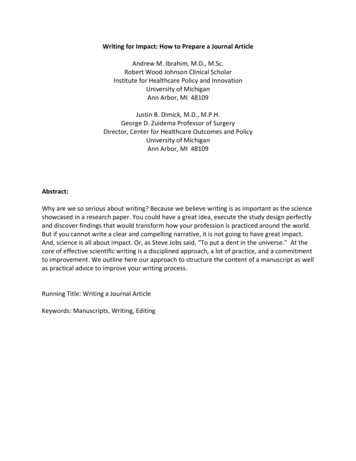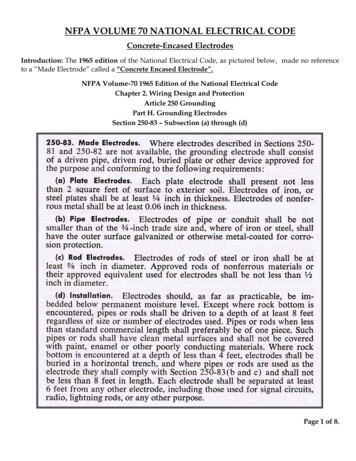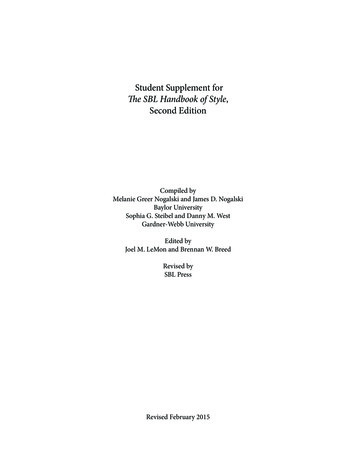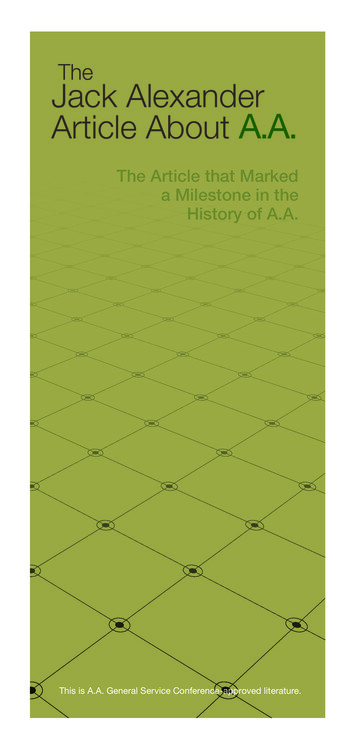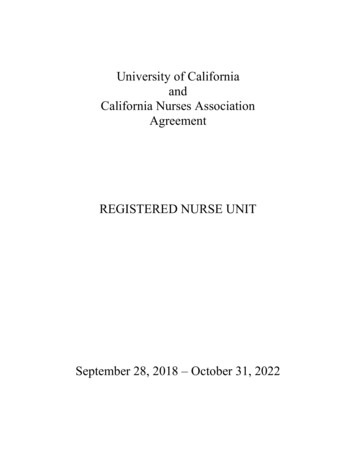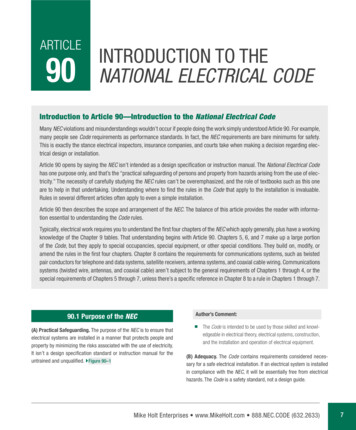
Transcription
ARTICLE90INTRODUCTION TO THENATIONAL ELECTRICAL CODEIntroduction to Article 90—Introduction to the National Electrical CodeMany NEC violations and misunderstandings wouldn’t occur if people doing the work simply understood Article 90. For example,many people see Code requirements as performance standards. In fact, the NEC requirements are bare minimums for safety.This is exactly the stance electrical inspectors, insurance companies, and courts take when making a decision regarding electrical design or installation.Article 90 opens by saying the NEC isn’t intended as a design specification or instruction manual. The National Electrical Codehas one purpose only, and that’s the “practical safeguarding of persons and property from hazards arising from the use of electricity.” The necessity of carefully studying the NEC rules can’t be overemphasized, and the role of textbooks such as this oneare to help in that undertaking. Understanding where to find the rules in the Code that apply to the installation is invaluable.Rules in several different articles often apply to even a simple installation.Article 90 then describes the scope and arrangement of the NEC. The balance of this article provides the reader with information essential to understanding the Code rules.Typically, electrical work requires you to understand the first four chapters of the NEC which apply generally, plus have a workingknowledge of the Chapter 9 tables. That understanding begins with Article 90. Chapters 5, 6, and 7 make up a large portionof the Code, but they apply to special occupancies, special equipment, or other special conditions. They build on, modify, oramend the rules in the first four chapters. Chapter 8 contains the requirements for communications systems, such as twistedpair conductors for telephone and data systems, satellite receivers, antenna systems, and coaxial cable wiring. Communicationssystems (twisted wire, antennas, and coaxial cable) aren’t subject to the general requirements of Chapters 1 through 4, or thespecial requirements of Chapters 5 through 7, unless there’s a specific reference in Chapter 8 to a rule in Chapters 1 through 7.90.1 Purpose of the NEC(A) Practical Safeguarding. The purpose of the NEC is to ensure thatelectrical systems are installed in a manner that protects people andproperty by minimizing the risks associated with the use of electricity.It isn’t a design specification standard or instruction manual for theuntrained and unqualified. }Figure 90–1Author’s Comment: The Code is intended to be used by those skilled and knowledgeable in electrical theory, electrical systems, construction,and the installation and operation of electrical equipment.(B) Adequacy. The Code contains requirements considered necessary for a safe electrical installation. If an electrical system is installedin compliance with the NEC, it will be essentially free from electricalhazards. The Code is a safety standard, not a design guide.Mike Holt Enterprises www.MikeHolt.com 888.NEC.CODE (632.2633)7
90.1 Introduction to the National Electrical Code}Figure 90–1NEC requirements aren’t intended to ensure the electrical installationwill be efficient, convenient, adequate for good service, or suitable forfuture expansion. Specific items of concern, such as electrical energymanagement, maintenance, and power quality issues aren’t within thescope of the Code. }Figure 90–2}Figure 90–3Author’s Comment: See the definition of “Overload” in Article 100. The NEC doesn’t require electrical systems to be designed orinstalled to accommodate future loads. However, the electricaldesigner (typically an electrical engineer) is concerned withnot only ensuring electrical safety (Code compliance), but alsowith ensuring the system meets the customers’ needs, bothof today and in the near future. To satisfy customers’ needs,electrical systems are often designed and installed above theminimum requirements contained in the NEC. But just remember,if you’re taking an exam, licensing exams are based on yourunderstanding of the minimum Code requirements.(C) Relation to International Standards. The requirements of the NECaddress the fundamental safety principles contained in the InternationalElectrotechnical Commission (IEC) Standard, including protection againstelectric shock, adverse thermal effects, overcurrent, fault currents, andovervoltage. }Figure 90–4}Figure 90–2Note: Hazards in electrical systems often occur because circuits are overloadedor not properly installed in accordance with the NEC. These often occur if the initialwiring didn’t provide reasonable provisions for system changes or for the increasein the use of electricity. }Figure 90–38Author’s Comment: The NEC is used in Chile, Ecuador, Peru, and the Philippines.It’s also the Electrical Code for Colombia, Costa Rica, Mexico,Panama, Puerto Rico, and Venezuela. Because of these adoptions, it’s available in Spanish from the National Fire ProtectionAssociation, 617.770.3000, or www.NFPA.org.Mike Holt’s Illustrated Guide to Understanding the 2017 National Electrical Code, Volume 1
Introduction to the National Electrical Code 90.2Author’s Comment: The NEC contains the following requirements on the removalof equipment and cables; temporary wiring 590.3 and abandoned cables for Audio [640.6(B)], Signaling [725.25], FireAlarm [760.25], Optical Fiber [770.25], Twisted Pair [800.25],and Coaxial [820.25].(1) Public and private premises, including buildings, mobile homes,recreational vehicles, and floating buildings. }Figure 90–6}Figure 90–490.2 Scope of the NEC(A) What Is Covered by the NEC. The NEC contains requirementsnecessary for the proper installation and removal of electrical conductors, equipment, cables, and raceways for power, signaling, fire alarm,optical cable, and communications systems (twisted wire, antennas,and coaxial cable) for: }Figure 90–5}Figure 90–6(2) Yards, lots, parking lots, carnivals, and industrial substations.(3) Conductors and equipment connected to the electric utility supply.(4) Installations used by an electric utility, such as office buildings,warehouses, garages, machine shops, recreational buildings, andother electric utility buildings that aren’t an integral part of a utility’s generating plant, substation, or control center. }Figure 90–7(B) What Isn’t Covered by the NEC. The NEC doesn’t apply to the installation of electrical or communications systems (twisted wire, antennas,and coaxial cable) for:}Figure 90–5(1) Transportation Vehicles. The NEC doesn’t apply to installationsin cars, trucks, boats, ships and watercraft, planes, or electric trains.(2) Mining Equipment. The NEC doesn’t apply to installations underground in mines and self‑propelled mobile surface mining machineryand its attendant electrical trailing cables.Mike Holt Enterprises www.MikeHolt.com 888.NEC.CODE (632.2633)9
90.2 Introduction to the National Electrical Code}Figure 90–7}Figure 90–9(3) Railways. The NEC doesn’t apply to railway power, signaling, energystorage, and communications wiring.(5) Electric Utilities. The NEC doesn’t apply to electrical installationsunder the exclusive control of an electric utility, where such installations:(4) Communications Utilities. If the installation is under the exclusivecontrol of the communications utility, the installation requirements ofthe NEC don’t apply to the communications (telephone) or network‑powered broadband utility equipment located in building spaces usedexclusively for these purposes, or located outdoors if the installation isunder the exclusive control of the communications utility. }Figure 90–8and }Figure 90–9a. Consist of electric utility installed service drops or service lateralsunder their exclusive control. }Figure 90–10}Figure 90–10b. Are on property owned or leased by the electric utility for thepurpose of generation, transformation, transmission, energystorage, distribution, or metering of electric energy. }Figure 90–11}Figure 90–810Mike Holt’s Illustrated Guide to Understanding the 2017 National Electrical Code, Volume 1
Introduction to the National Electrical Code 90.3d. Are located by other written agreements either designated byor recognized by public service commissions, electric utilitycommissions, or other regulatory agencies having jurisdictionfor such installations; limited to installations for the purpose ofcommunications, metering, generation, control, transformation,transmission, energy storage, or distribution of electric energywhere legally established easements or rights‑of‑way can’t beobtained. These installations are limited to federal lands, NativeAmerican reservations through the U.S. Department of the InteriorBureau of Indian Affairs, military bases, lands controlled by portauthorities and state agencies and departments, and lands ownedby railroads.Note to 90.2(B)(4) and (5): Utilities include entities that install, operate, and maintain communications systems (twisted wire, antennas, and coaxial cable) or electricsupply (generation, transmission, or distribution systems) and are designated orrecognized by governmental law or regulation by public service/utility commissions.Utilities may be subject to compliance with codes and standards covering their regulated activities as adopted under governmental law or regulation.}Figure 90–11Author’s Comment: Luminaires located in legally established easements, orrights‑of‑way, such as at poles supporting transmission ordistribution lines, are exempt from the NEC. However, if the electric utility provides site and public lighting on private property,then the installation must comply with the Code [90.2(A)(4)].c. Are located on legally established easements or rights‑of‑way.}Figure 90–1290.3 Code ArrangementGeneral Requirements. The Code is divided into an introduction andnine chapters followed by informational annexes. Chapters 1, 2, 3, and4 are general conditions. }Figure 90–13}Figure 90–13}Figure 90–12Mike Holt Enterprises www.MikeHolt.com 888.NEC.CODE (632.2633)11
90.4 Introduction to the National Electrical CodeAuthor’s Comment: These first four chapters may be thought of as the foundationfor the rest of the Code.The Code is intended to be suitable for enforcement by governmentalbodies that exercise legal jurisdiction over electrical installations forpower, lighting, signaling circuits, and communications systems, suchas: }Figure 90–14Special Requirements. The requirements contained in Chapters 5, 6,and 7 apply to special occupancies, special equipment, or other specialconditions, which may supplement or modify the requirements containedin Chapters 1 through 7, but not Chapter 8.Communications Systems. Chapter 8 contains the requirements forcommunications systems (twisted wire, antennas, and coaxial cable)which aren’t subject to the general requirements of Chapters 1 through4, or the special requirements of Chapters 5 through 7, unless there’s aspecific reference in Chapter 8 to a rule in Chapters 1 through 7.Author’s Comment: An example of how Chapter 8 works is in the rules for workingspace about equipment. The typical 3-ft working space isn’trequired in front of communications equipment, because Table110.26(A)(1) isn’t referenced in Chapter 8.Tables. Chapter 9 consists of tables applicable as referenced in theNEC. The tables are used to calculate raceway sizing, conductor fill, theradius of raceway bends, and conductor voltage drop.Annexes. Annexes aren’t part of the Code, but are included for informational purposes. There are ten annexes: Annex A. Product Safety Standards Annex B. Application Information for Ampacity Calculation Annex C. Raceway Fill Tables for Conductors and FixtureWires of the Same Size Annex D. Examples Annex E. Types of Construction Annex F. Critical Operations Power Systems (COPS) Annex G. Supervisory Control and DataAcquisition (SCADA) Annex H. Administration and Enforcement Annex I. Recommended Tightening Torques Annex J. ADA Standards for Accessible Design90.4 EnforcementScan this QR code for a video of Mike explaining this topic; it’sa sample from the DVDs that accompany this textbook.12}Figure 90–14Signaling circuits which include: Article 725 Class 1, Class 2, and Class 3 RemoteControl, Signaling, and Power-Limited CircuitsArticle 760 Fire Alarm SystemsArticle 770 Optical Fiber Cables and RacewaysCommunications systems which include: Article 810 Radio and Television Equipment (satellite dishand antenna) Article 820 Community Antenna Television and RadioDistribution Systems (coaxial cable)Author’s Comment:nThe installation requirements for signaling circuits and communications circuits are covered in Mike Holt’s Understanding theNational Electrical Code, Volume 2 textbook.The enforcement of the NEC is the responsibility of the authority havingjurisdiction (AHJ), who is responsible for interpreting requirements,approving equipment and materials, waiving Code requirements, andensuring equipment is installed in accordance with listing instructions.Mike Holt’s Illustrated Guide to Understanding the 2017 National Electrical Code, Volume 1
Introduction to the National Electrical Code 90.4Author’s Comment:nSee the definition of “Authority Having Jurisdiction” in Article 100.Interpretation of the Requirements. The authority having jurisdiction isresponsible for interpreting the NEC.Author’s Comment:nThe AHJ’s decisions must be based on a specific Coderequirement. If an installation is rejected, the authority havingjurisdiction is legally responsible for informing the installer ofthe specific NEC rule that was violated. }Figure 90–15}Figure 90–16Author’s Comment:nAccording to the NEC, the authority having jurisdiction determines the approval of equipment. This means he or she canreject an installation of listed equipment and can approve theuse of unlisted equipment. Given our highly litigious society,approval of unlisted equipment is becoming increasingly difficult to obtain.Approval of Alternate Means. By special permission, the authority havingjurisdiction may approve alternate methods where it’s assured equivalent safety can be achieved and maintained.}Figure 90–15Author’s Comment:nAuthor’s Comment:nThe art of getting along with the authority having jurisdictionconsists of doing good work and knowing what the Code actually says (as opposed to what you only think it says). It’s alsouseful to know how to choose your battles when the inevitabledisagreement does occur.Approval of Equipment and Materials. Only the authority having jurisdiction has authority to approve the installation of equipment andmaterials. Typically, the authority having jurisdiction will approve equipment listed by a product testing organization, such as UnderwritersLaboratories, Inc. (UL). The NEC doesn’t require all equipment to belisted, but many state and local AHJs do. See 90.7, 110.2, 110.3, andthe definitions for “Approved,” “Identified,” “Labeled,” and “Listed” inArticle 100. }Figure 90–16Special permission is defined in Article 100 as the writtenconsent of the authority having jurisdiction.Waiver of New Product Requirements. If the current NEC requiresproducts that aren’t yet available at the time the Code is adopted, theauthority having jurisdiction can allow products that were acceptablein the previous Code to continue to be used.Author’s Comment:nSometimes it takes years before testing laboratories establish product standards for new NEC requirements, and thenit takes time before manufacturers can design, manufacture,and distribute those products to the marketplace.Mike Holt Enterprises www.MikeHolt.com 888.NEC.CODE (632.2633)13
90.5 Introduction to the National Electrical Code90.5 Mandatory Requirementsand Explanatory Material(A) Mandatory Requirements. In the NEC the words “shall” or “shallnot,” indicate a mandatory requirement.Author’s Comment:nFor the ease of reading this textbook, the word “shall” hasbeen replaced with the word “must,” and the words “shallnot” have been replaced with “must not.” Remember that inmany places, we’ll paraphrase the Code instead of providingexact quotes, to make it easier to read and understand.(B) Permissive Requirements. When the Code uses “shall be permitted”it means the identified actions are permitted but not required, and theauthority having jurisdiction isn’t permitted to restrict an installation frombeing completed in that manner. A permissive rule is often an exception to the general requirement.Author’s Comment:nFor ease of reading, the phrase “shall be permitted,” as usedin the Code, has been replaced in this textbook with the phrase“is permitted” or “are permitted.”(C) Explanatory Material. References to other standards or sections ofthe NEC, or information related to a Code rule, are included in the formof Informational Notes. Such notes are for information only and aren’tenforceable as requirements of the NEC.90.6 Formal InterpretationsTo promote uniformity of interpretation and application of the provisionsof the NEC, formal interpretation procedures have been establishedand are found in the NFPA Regulations Governing Committee Projects.Author’s Comment:nThis is rarely done because it’s a very time-consuming process,and formal interpretations from the NFPA aren’t binding onthe authority having jurisdiction.90.7 Examination of Equipmentfor Product SafetyProduct evaluation for safety is typically performed by a nationallyrecognized testing laboratory that’s approved by the authority havingjurisdiction. The suitability of equipment use is determined by the application of product safety listing standards that are compatible with the NEC.Author’s Comment: See Article 100 for the definition of “Approved.”Except to detect alterations or damage, listed factory‑installed internalwiring and construction of equipment need not be inspected at the timeof installation [300.1(B)]. }Figure 90–17For example, Informational Note 4 in 210.19(A)(1) recommends that thevoltage drop of a circuit not exceed 3 percent. This isn’t a requirement;it’s just a recommendation.Author’s Comment:nFor convenience and ease of reading in this textbook,Informational Notes will simply be identified as “Note.”nInformational Notes aren’t enforceable, but Table Notes are.This textbook will call notes found in a table “Table Notes.”(D) Informative Annexes. Nonmandatory information annexes containedin the back of the Code book are for information only and aren’t enforceable as requirements of the NEC.14}Figure 90–17Mike Holt’s Illustrated Guide to Understanding the 2017 National Electrical Code, Volume 1
Introduction to the National Electrical Code 90.9(D) Compliance. Installing electrical systems in accordance withthe metric system or the inch-pound system is considered to complywith the Code.Note 1: See 110.3 on the required use of listed products.Note 2: “Listed” is defined in Article 100.Note 3: Annex A contains a list of product safety standards that comply with the NEC.Author’s Comment:n90.9 Units of Measurement(B) Dual Systems of Units. Both the metric and inch-pound measurement systems are shown in the NEC, with the metric units appearingfirst and the inch-pound system immediately following in parentheses.Since the use of either the metric or the inch-pound system ofmeasurement constitutes compliance with the NEC, this textbook uses only inch-pound units.Author’s Comment:nThis is the standard practice in all NFPA standards, eventhough the U.S. construction industry uses inch-pound unitsof measurement. You’ll need to be cautious when using thetables in the Code because the additional units can make thetables more complex and more difficult to read.Mike Holt Enterprises www.MikeHolt.com 888.NEC.CODE (632.2633)15
10 Mike Holt’s Illustrated Guide to Understanding the 2017 National Electrical Code, Volume 1 90.2 Introduction to the National Electrical Code (5) Electric Utilities. The NEC doesn’t apply to electrical installations under the exclusive control of an electric utility, where such installations: a. Consist of ele





